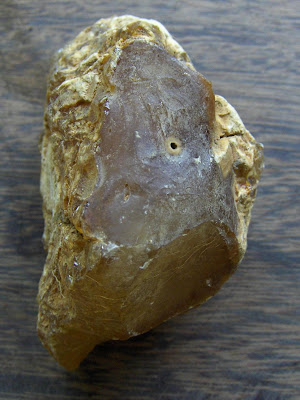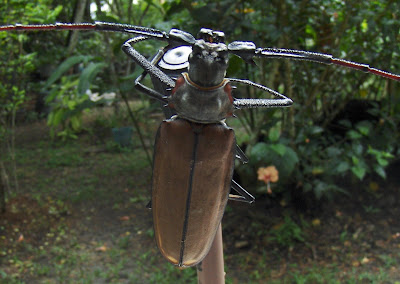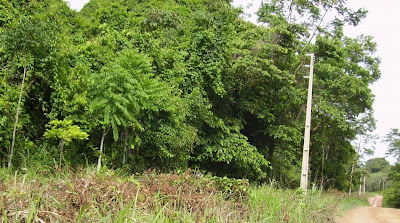
My friend and neighbor at Bosque Santa Lúcia is Joaquim Lira Maia. As my readers may have deduced from previous posts, he's my neighbor because his land borders on the northern part of the Bosque. He's my friend because I've known him and his family since arriving in Santarém in 1979. They're from Cipoal, which is located on BR-163, the federal highway that connects Santarém to Cuiabá in the State of Mato Grosso. When I arrived that year, Maia was finishing up his university studies in Belém at the School of Agronomy. I got to know his family because I was working in public health and Cipoal had been selected as one of the first communities to participate in the "barefoot doctors" program, more appropriately called "atendente de saúde pública". The community selected Maia's sister, Fátima, as the person to be trained. She wasn't more than a kid at that time, finishing up her high school studies in Santarém because there wasn't one in Cipoal. The commute wasn't an easy task because not one inch of the highway was paved. It was Maia's other sister, Mariquinha, who told me about a farm down a road on the other side of the highway that was up for sale. I checked it out one day, liked what I saw and we bought it, to be paid for over the next six months. That was the beginning of what is Bosque Santa Lúcia today. Maia's parents and his many siblings lived a few hundred meters off the highway in in a small mud and wattle house. They were agriculture people in the best sense of the word. Everyone worked the land in a slash and burn fashion, including Maia. His nickname was "jato", which means jet. So called because he suffered a childhood paralysis that left him with a one leg that dragged behind the other. But that didn't slow him down. He moved about like a jet. He was also bestowed with high intelligence and a gift for speech, which eventually got him in politics. I don't remember all the offices he's held over the years, but I know that he was secretary of agriculture for this state of Pará, at least one term. He was also congressman for this state, maybe two terms. He was elected mayor of Santarém and the municipality for two terms and he's now a national congressman from Pará. As you can see from the attached picture, he's still a young man. As a rural extension agent said at a community meeting I attended in Cipoal, "no small stuff for a kid, who was out in the field hoeing corn and beans not long ago." I consider Lira Maia a friend too because I used to spend a lot of time with his mother and father when I first came to Santarém. They both smoked homemade pipes and I had been a pipe smoker for many years. We traded pipes, we traded tobacco and drank a lot of homegrown coffee in that little house with mud walls and a dirt floor. I never got to know Maia the way I got to know the rest of the family, but to this day we're invited to occasional family type affairs. He's always treated us with friendship and respect. It is an overstatement to say that politicians have their fans and enemies ... and certainly Maia is no different. There are people who hate him and what he stands for in his stance for development of the Amazon. He was the key figure in bringing soy and mechanized agriculture to the region. There people who will never forgive him for that deed. The world of politics seems to mandate that you kick the shit out of your opponents in any way you can. The higher up on the totem pole, the more you get kicked. Law of the jungle! I'm basically an environmentalist, but I believe in a rational management of development. In an interview with a BBC reporter from Vietnam a few days ago, I talked about that in great length. In another post, I'll present those views. Right now I'd like to get back to my tropical biodiversity of flora and fauna at Bosque Santa Lucia.

 The readers of my blog, Tropical Biodiversity - The Amazon, will remember that I was concerned about whether a pajurá de Óbidos (Pouteria speciosa) seed would germinate. It was the second of two seeds I received from a collector of rare fruit trees. The first seed had germinated long ago but the one in question didn't seem to be making it. Then I discovered that I had placed the seed upside down. Real smart! Turning it over, it began to show signs of splitting a few days later. Then came some green as it germinated! A few days ago Cleuson placed the seedling into the ground and as you can see in the lower image, it's doing quite well. Seed in the upper image.
The readers of my blog, Tropical Biodiversity - The Amazon, will remember that I was concerned about whether a pajurá de Óbidos (Pouteria speciosa) seed would germinate. It was the second of two seeds I received from a collector of rare fruit trees. The first seed had germinated long ago but the one in question didn't seem to be making it. Then I discovered that I had placed the seed upside down. Real smart! Turning it over, it began to show signs of splitting a few days later. Then came some green as it germinated! A few days ago Cleuson placed the seedling into the ground and as you can see in the lower image, it's doing quite well. Seed in the upper image.















































